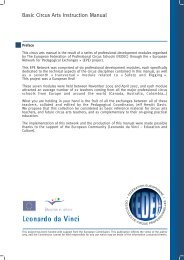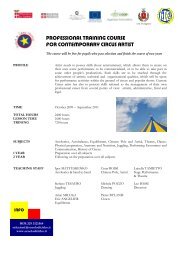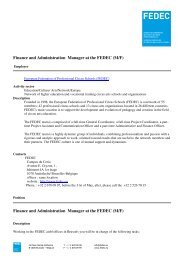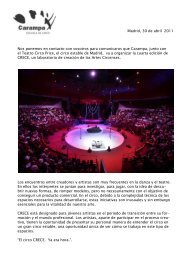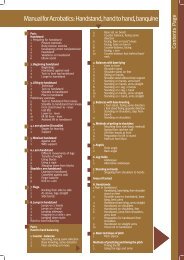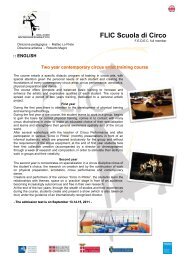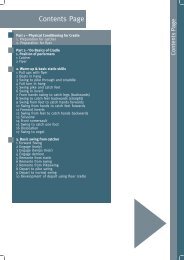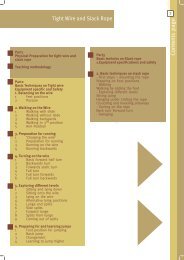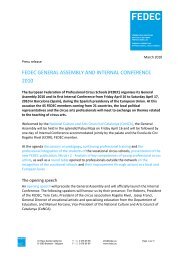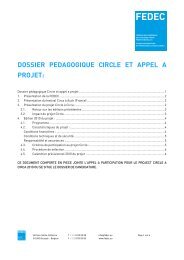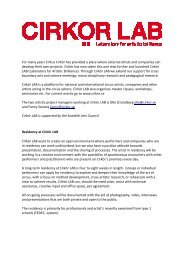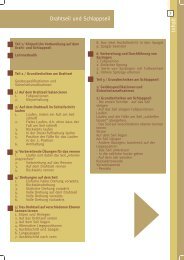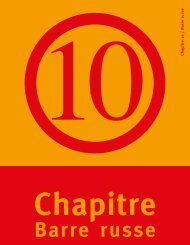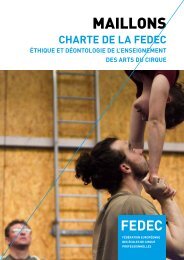InstructIon MAnuAL - Fedec
InstructIon MAnuAL - Fedec
InstructIon MAnuAL - Fedec
You also want an ePaper? Increase the reach of your titles
YUMPU automatically turns print PDFs into web optimized ePapers that Google loves.
PREAMbLE<br />
First and only network for international exchange and cooperation<br />
in the field of vocational training of circus artists, the FEDEc has a unique<br />
mission to develop circus arts pedagogy<br />
Between 2005 and 2007, FeDec coordinated a series of<br />
european Pedagogical exchanges that, for the first time<br />
ever, allowed teachers of different nationalities and from<br />
different schools around the world to meet together to<br />
focus on 6 circus disciplines (or groups of specialisms).<br />
these weeklong meetings were synthesised into the<br />
chapters that now make up the Basic circus arts instruction<br />
manual.<br />
the development of this manual was undertaken with the<br />
intention of creating a guide to best practice for higher<br />
education, vocational and preparatory schools, including<br />
the most thorough requirements in terms of injury<br />
prevention. transdisciplinary issues such as rigging and<br />
safety, physical conditioning, and artistic development<br />
are therefore dealt with as key cross-cutting elements in<br />
the context of the disciplinary chapters, and in the case<br />
of rigging & safety and physical conditioning, treated as<br />
separate chapter topics in their own right. .<br />
the innovative nature of this series of exchanges was<br />
recognised by the 2009 creativity and innovation Golden<br />
award from the european commission.<br />
on the strength of this acknowledgement and keen to<br />
further develop the range of pedagogical circus arts<br />
tools available, the FeDec network has formed a focus<br />
group comprised of experts from a variety of schools,<br />
aiming to identify the educational challenges faced today<br />
and to consider how solutions to these challenges might<br />
be implemented.<br />
Based on the work of the previous years and the issues<br />
subsequently raised by teachers, the focus group has<br />
begun to conduct an analysis and evaluation of the<br />
existing chapters. Between 2010 and 2015 the focus<br />
group’s task is to coordinate the revision of the original<br />
chapters, as well as to address emerging and innovative<br />
circus arts disciplines.<br />
like any educational publication, the manual must<br />
be continually revised and adapted. the focus group<br />
has therefore developed a methodology for revising<br />
the manual and ensuring that core elements of circus<br />
training are covered.<br />
throughout the manual, FeDec considers the acquisition<br />
of circus techniques as an artistic discipline in its own<br />
right, complementary to the technical standards required<br />
by particular circus specialisms. as well as focusing on<br />
specific disciplines, the manual is committed to exploring<br />
artistic codes of practice such as intuition and perception<br />
and the various fundamental relationships of circus arts<br />
(the artist’s relationship with his/her partner, the apparatus,<br />
the space and the audience).<br />
FeDec does not wish to impose any specific aesthetic<br />
approach, but instead hopes to lead teachers to develop<br />
educational methodologies that integrate artistic considerations<br />
into a holistic training programme. it’s up to<br />
each teacher to put this into practice as he/she sees fit<br />
when devising his/her own methods for supporting his/<br />
her students’ progress.<br />
4 CYR WHEEL © fedec 2011



